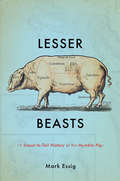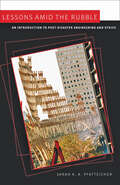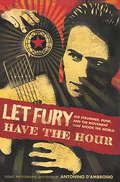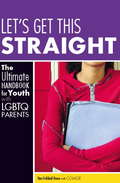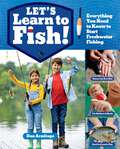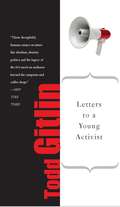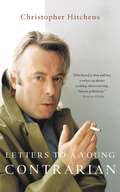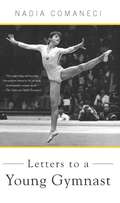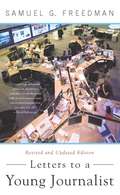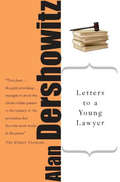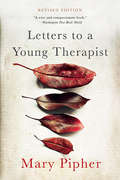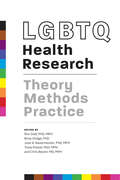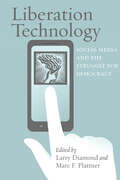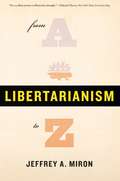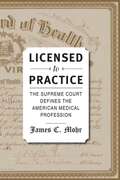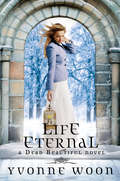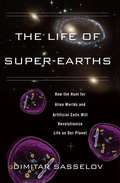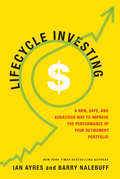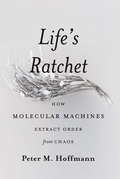- Table View
- List View
Lesser Beasts: A Snout-to-Tail History of the Humble Pig
by Mark EssigUnlike other barnyard animals, which pull plows, give eggs or milk, or grow wool, a pig produces only one thing: meat. Incredibly efficient at converting almost any organic matter into nourishing, delectable protein, swine are nothing short of a gastronomic godsend-yet their flesh is banned in many cultures, and the animals themselves are maligned as filthy, lazy brutes.As historian Mark Essig reveals in Lesser Beasts, swine have such a bad reputation for precisely the same reasons they are so valuable as a source of food: they are intelligent, self-sufficient, and omnivorous. What’s more, he argues, we ignore our historic partnership with these astonishing animals at our peril. Tracing the interplay of pig biology and human culture from Neolithic villages 10,000 years ago to modern industrial farms, Essig blends culinary and natural history to demonstrate the vast importance of the pig and the tragedy of its modern treatment at the hands of humans. Pork, Essig explains, has long been a staple of the human diet, prized in societies from Ancient Rome to dynastic China to the contemporary American South. Yet pigs’ ability to track down and eat a wide range of substances (some of them distinctly unpalatable to humans) and convert them into edible meat has also led people throughout history to demonize the entire species as craven and unclean. Today’s unconscionable system of factory farming, Essig explains, is only the latest instance of humans taking pigs for granted, and the most recent evidence of how both pigs and people suffer when our symbiotic relationship falls out of balance.An expansive, illuminating history of one of our most vital yet unsung food animals, Lesser Beasts turns a spotlight on the humble creature that, perhaps more than any other, has been a mainstay of civilization since its very beginnings-whether we like it or not.
Lessons amid the Rubble: An Introduction to Post-Disaster Engineering and Ethics (Johns Hopkins Introductory Studies in the History of Technology)
by Sarah K. PfatteicherThe aftermath of September 11, 2001, brought the subject of engineering-failure forensics to public attention as had no previous catastrophe. In keeping with the engineering profession's long tradition of building a positive future out of disasters, Lessons amid the Rubble uses the collapse of the World Trade Center towers to explore the nature and future of engineering education in the United States. Sarah K. A. Pfatteicher draws on historical and current practice in engineering design, construction, and curricula to discuss how engineers should conceive, organize, and execute a search for the reasons behind the failure of man-made structures. Her survey traces the analytical journey engineers take after a disaster and discusses the technical, social, and moral implications of their work. After providing an overview of the investigations into the collapse of the Twin Towers, Pfatteicher explores six related events to reveal deceptively simple lessons about the engineering enterprise, each of which embodies an ethical dilemma at the heart of the profession. In tying these themes together, Pfatteicher highlights issues of professionalism and professional identity infused in engineering education and encourages an explicit, direct conversation about their meaning.Sophisticated and engagingly written, this volume combines history, engineering, ethics, and philosophy to provoke a deep discussion about the symbolic meaning of buildings and other structures and the nature of engineering.
Let Fury Have the Hour: Joe Strummer, Punk, and the Movement that Shook the World
by Antonino D’AmbrosioJoe Strummer's untimely death at the age of fifty in December 2002 took from us one of the truly unique voices of modern music. The quintessential Rude Boy, punker, rebel musician, artist and activist, Strummer wrote some of the most important and influential music of the last century including "Guns of Brixton," "The Washington Bullets," "Spanish Bombs," "White Man in Hammersmith Palace," "London's Burning," "Lost in the Supermarket," and "Garageland." Effectively melding raw creativity with radical politics, Strummer transformed punk rock from its early associations with reactionary, right wing and nihilistic politics into a social movement. From Rock Against Racism to the Anti-Nazi League Festival to supporting the H-Block protests, Strummer and The Clash led the charge for human rights. Let Fury Have the Hour collects articles, interviews, essays and reviews that chronicle Strummer's life both as a musician and a political activist. Included in this collection are essays and interviews by Antonino D'Ambrosio, alongside contributions from Peter Silverton, Barry Miles, Anya Philips, Sylvia Simmons, Vic Garbarini, Caroline Coons, Todd Martens, Joel Schalit and others. This book also includes original lyrics, photography, art, posters, and flyers, and offers the first serious examination of the life of this extraordinary man.
Let Fury Have the Hour: Joe Strummer, Punk, and the Movement that Shook the World
by Antonino D’AmbrosioJoe Strummer's untimely death at the age of fifty in December 2002 took from us one of the truly unique voices of modern music. The quintessential Rude Boy, punker, rebel musician, artist and activist, Strummer wrote some of the most important and influential music of the last century including "Guns of Brixton," "The Washington Bullets," "Spanish Bombs," "White Man in Hammersmith Palace," "London's Burning," "Lost in the Supermarket," and "Garageland." Effectively melding raw creativity with radical politics, Strummer transformed punk rock from its early associations with reactionary, right wing and nihilistic politics into a social movement. From Rock Against Racism to the Anti-Nazi League Festival to supporting the H-Block protests, Strummer and The Clash led the charge for human rights. Let Fury Have the Hour collects articles, interviews, essays and reviews that chronicle Strummer's life both as a musician and a political activist. Included in this collection are essays and interviews by Antonino D'Ambrosio, alongside contributions from Peter Silverton, Barry Miles, Anya Philips, Sylvia Simmons, Vic Garbarini, Caroline Coons, Todd Martens, Joel Schalit and others. This book also includes original lyrics, photography, art, posters, and flyers, and offers the first serious examination of the life of this extraordinary man.
Let's Get This Straight: The Ultimate Handbook for Youth with LGBTQ Parents
by Tina Fakhrid-DeenLet’s Get This Straight reaches out to young people with one or more gay, lesbian, bi, or trans parents to provide them with the tools to combat homophobia, take pride in their alternative family structures, and speak out against injustice. This short but thorough book profiles forty-five diverse youth and young adults, all of whom voice their opinions and provide advice for other youth living in LGBTQ households. Let’s Get This Straight also includes probing questions, fun activities, engaging quizzes, and reflective journal sections for youth to share their feelings and experiences about having a gay parent. By reading this book, readers will learn how to: identify and overcome barriers to having a gay parent; address discrimination and heterosexism; build a strong self-esteem and sense of belonging; communicate effectively with their parents and individuals outside of the LGBTQ community; access resources and support for their families; respond effectively when challenged about being in a sexual minority family; and reduce the isolation, fear, shame, and confusion that can be associated with having gay parents. As the media brings ever-increasing exposure to gay-headed households, this book is more important than ever. Let’s Get This Straight is the perfect blend of wit, sharing of experiences, and "expert” advice that children with LGBTQ parents need to become more self-aware and affirming, and to maintain healthy relationships with their parents.
Let's Learn to Fish!: Everything You Need to Know to Start Freshwater Fishing
by Dan ArmitageIn this exciting introduction to freshwater fishing, fishing expert Dan Armitage teaches kids about the best bait and tackle, how to rig a rod, cast a line, and reel in their first fish. Grab a fishing rod and head out to a nearby stream or lake for a fishing adventure! In this skills-based book, kids ages 6 and up go on a fishing trip, led by author and fishing guide Dan Armitage of the Kids' Fishing Fun Program, and learn essential techniques, facts, and tips to learn how to fish and catch a big one! Step-by-step color photography shows everything kids need, the best beginner bait and tackle, key fishing skills such as rigging, casting, and reeling in fish, and tips on where to fish for crappies, bass, catfish, perch, trout, and more. Kids record fishing adventures in the log at the back of the book. The skills teach fun fishing know-how, connect kids to nature, and foster independence and self-reliance.
Letters to a Young Activist (Letters To A Young... Ser.)
by Todd Gitlin"Be original. See what happens." So Todd Gitlin advises the young mind burning to take action to right the wrongs of the world but also looking for bearings, understanding, direction, and practical examples.In Letters to a Young Activist, Todd Gitlin looks back at his eventful life, recalling his experience as president of the formidable Students for a Democratic Society in the '60s, contemplating the spirit of activism, and arriving at some principles of action to guide the passion and energy of those wishing to do good. He considers the three complementary motives of duty, love, and adventure, and reflects on the changing nature of idealism and how righteous action requires realistic as well as idealistic thinking. And he looks forward to an uncertain future that is nevertheless full of possibility, a future where patriotism and intelligent skepticism are not mutually exclusive.Gitlin invites the young activist to enter imaginatively into some of the dilemmas, moral and practical, of being a modern citizen--the dilemmas that affect not only the problems of what to think but also the problems of what to love and how to live.
Letters to a Young Contrarian (Letters To A Young... Ser.)
by Christopher HitchensFrom bestselling author and provocateur Christopher Hitchens, the classic guide to the art of principled dissent and disagreementIn Letters to a Young Contrarian, bestselling author and world-class provocateur Christopher Hitchens inspires the radicals, gadflies, mavericks, rebels, and angry young (wo)men of tomorrow. Exploring the entire range of "contrary positions"--from noble dissident to gratuitous nag--Hitchens introduces the next generation to the minds and the misfits who influenced him, invoking such mentors as Emile Zola, Rosa Parks, and George Orwell. As is his trademark, Hitchens pointedly pitches himself in contrast to stagnant attitudes across the ideological spectrum. No other writer has matched Hitchens's understanding of the importance of disagreement--to personal integrity, to informed discussion, to true progress, to democracy itself.
Letters to a Young Contrarian
by Christopher Hitchens"Art of Mentoring" seriesIn the book that he was born to write, provocateur and best-selling author Christopher Hitchens inspires future generations of radicals, gadflies, mavericks, rebels, angry young (wo)men, and dissidents. Who better to speak to that person who finds him or herself in a contrarian position than Hitchens, who has made a career of disagreeing in profound and entertaining ways. This book explores the entire range of "contrary positions"-from noble dissident to gratuitous pain in the butt. In an age of overly polite debate bending over backward to reach a happy consensus within an increasingly centrist political dialogue, Hitchens pointedly pitches himself in contrast. He bemoans the loss of the skills of dialectical thinking evident in contemporary society. He understands the importance of disagreement-to personal integrity, to informed discussion, to true progress-heck, to democracy itself. Epigrammatic, spunky, witty, in your face, timeless and timely, this book is everything you would expect from a mentoring contrarian.
Letters to a Young Gymnast (Letters To A Young... Ser.)
by Nadia ComaneciIf there were such a thing as an "elder" stateswoman in women's gymnastics today, Nadia Comaneci would win that title as readily as she once won gold medals. Olga Korbut came before her, and many other medalists would follow, but none has ever been as dominant in winning the hearts of millions around the world. With grit and determination, Nadia Comaneci ushered in a new era for women's sports, one where young girls could vault into the arena of superstardom. Even today, almost thirty years after her greatest triumphs, you need only mention the name "Nadia" and gymnastics fans know instantly whom you are talking about.In Letters to a Young Gymnast, Nadia shows what it takes to achieve athletic perfection and become the best. With inspiring and dramatic stories from her own experience, she tells us how the young girl that Bela Karolyi discovered in a Romanian elementary school found the inner strength to become a world-class athlete at such a young age. This collection of Nadia's memories, anecdotes, and advice grants unique insights into the mind of a top competitor. From how to live after you've realized your dream, to the necessity of "a spirit forged with mettle," Nadia's thoughts on athleticism and sacrifice are eye-opening and surprisingly challenging.
Letters to a Young Journalist (Art Of Mentoring Ser.)
by Samuel G. FreedmanOver the course of a thirty-year career, Samuel Freedman has excelled both at doing journalism and teaching it, and he passionately engages both of these endeavors in the pages of this book. As an author and journalist, Freedman has produced award-winning books, investigative series, opinion columns, and feature stories and has become a specialist in a wide variety of fields. As a teacher, he has shared his expertise and experience with hundreds of students, who have gone on to succeed in both print and broadcast media. In Letters to a Young Journalist, Freedman conducts an extended conversation with young journalists-from kids on the high school paper to graduates starting their first jobs. Whether he's talking about radio documentaries or TV news shows, Internet blogs, or backwater beats, shoeleather research or elegant prose, his goal is to explore the habits of mind that make an excellent journalist. It is no secret that journalism's mission is seriously imperiled these days, and Freedman's provocative ideas and fascinating stories offer students and journalists at all levels of experience wise guidance and professional inspiration.
Letters to a Young Lawyer
by Alan M. DershowitzAs defender of both the righteous and the questionable, Alan Dershowitz has become perhaps the most famous and outspoken attorney in the land. Whether or not they agree with his legal tactics, most people would agree that he possesses a powerful and profound sense of justice. In this meditation on his profession, Dershowitz writes about life, law, and the opportunities that young lawyers have to do good and do well at the same time.We live in an age of growing dissatisfaction with law as a career, which ironically comes at a time of unprecedented wealth for many lawyers. Dershowitz addresses this paradox, as well as the uncomfortable reality of working hard for clients who are often without many redeeming qualities. He writes about the lure of money, fame, and power, as well as about the seduction of success. In the process, he conveys some of the "tricks of the trade" that have helped him win cases and become successful at the art and practice of "lawyering."
Letters to a Young Therapist: Stories Of Hope And Healing By The Author Of The Bestselling Surviving Ophelia (Letters To A Young... Ser.)
by Mary PipherFrom "one of America's best-known psychologists" (Chicago Tribune) and the bestselling author of Women Rowing North and Reviving Ophelia, an essential and inspiring book for therapists and anyone seeking to live a good lifeMary Pipher's groundbreaking investigation of America's "girl-poisoning culture," Reviving Ophelia, established its author as one of the nation's foremost authorities on family issues. In Letters to a Young Therapist, Pipher shares what she has learned in thirty years of clinical practice, helping warring families, alienated adolescents, and harried professionals restore peace and beauty to their lives. Through an exhilarating mix of storytelling and sharp-eyed observation, Pipher reveals her refreshingly inventive approach to therapy-fiercely optimistic, free of dogma or psychobabble, and laced with generous warmth and practical common sense. Whether she's recommending daily swims for a sluggish teenager, encouraging a timid husband to become bolder, or simply bearing witness to a bereaved parent's sorrow, Pipher's compassion and insight shine from every page. With a preface by the author addressing recent changes in therapy and the surprising challenges of the digital age, Letters to a Young Therapist is a powerfully engaging guide to living a healthy life.
LGBTQ Health Research: Theory, Methods, Practice
by Ron Stall PHD, MPH, et al.Over the last 30 years, the health needs of lesbian, gay, bisexual, transgender, and queer Americans have become increasingly recognized, in particular for the ways in which they are distinct from those typically assessed and addressed in society. Universities and researchers are paying greater attention to LGBTQ public health issues and how they might adapt existing methods to research marginalized communities, but—until now—there has been no authoritative resource to guide their education or practice. Developed for graduate students in public health and health sciences—but perfect for anyone interested in this topic—this book will fill that gap and provide the necessary public health tools to teach about and study LGBTQ populations effectively. Divided into three sections and edited by top scholars, LGBTQ Health Research explains research methods important to descriptive epidemiology that are needed to document health disparities among LGBTQ populations. The book also examines research methods that help explain the driving forces of these disparities. Focusing on real-world experience in developing and testing interventions to mitigate health disparities in LGBTQ populations, it also breaks down issues that challenge the direct application of standard research methods with these communities, including those related to sampling, measurement, choice of theoretical variables to explain the distribution of health and illness, cultural competence in intervention design, and community participation.Promoting the creation and diffusion of effective interventions, the book takes a holistic approach to address longstanding research gaps regarding important marginalized communities. It also documents profound health disparities in many LBGTQ populations across a wide range of health conditions and explains why future development of the field must be based on inclusive science and rigorous research methods. LGBTQ Health Research is an essential textbook for any courses that deal with the intersection of marginalization, health, sexuality, and gender.Contributors: José A. Bauermeister, Chris Beyrer, Kerith Conron, Brian Dodge, Rita Dwan, Stephen L. Forssell, Peter Gamache, Gary W. Harper, Mark L. Hatzenbuehler, Colleen Hoff, Carl Latkin, Ilan H. Meyer, Robin Lin Miller, Angulique Y. Outlaw, Christopher Owens, Tonia Poteat, Erin Riley, Joshua Rosenberger, Ayden I. Scheim, Shauna Stahlman, Randall Sell, Ron Stall, Rob Stephenson, Rachel Strecher, Ryan C. Tingler, Karin E. Tobin, Ronald O. Valdiserri, and Richard J. Wolitski
LGBTQ Health Research: Theory, Methods, Practice
by Ron Stall Brian Dodge José A. Bauermeister Tonia Poteat Chris BeyrerOver the last 30 years, the health needs of lesbian, gay, bisexual, transgender, and queer Americans have become increasingly recognized, in particular for the ways in which they are distinct from those typically assessed and addressed in society. Universities and researchers are paying greater attention to LGBTQ public health issues and how they might adapt existing methods to research marginalized communities, but—until now—there has been no authoritative resource to guide their education or practice. Developed for graduate students in public health and health sciences—but perfect for anyone interested in this topic—this book will fill that gap and provide the necessary public health tools to teach about and study LGBTQ populations effectively. Divided into three sections and edited by top scholars, LGBTQ Health Research explains research methods important to descriptive epidemiology that are needed to document health disparities among LGBTQ populations. The book also examines research methods that help explain the driving forces of these disparities. Focusing on real-world experience in developing and testing interventions to mitigate health disparities in LGBTQ populations, it also breaks down issues that challenge the direct application of standard research methods with these communities, including those related to sampling, measurement, choice of theoretical variables to explain the distribution of health and illness, cultural competence in intervention design, and community participation.Promoting the creation and diffusion of effective interventions, the book takes a holistic approach to address longstanding research gaps regarding important marginalized communities. It also documents profound health disparities in many LBGTQ populations across a wide range of health conditions and explains why future development of the field must be based on inclusive science and rigorous research methods. LGBTQ Health Research is an essential textbook for any courses that deal with the intersection of marginalization, health, sexuality, and gender.Contributors: José A. Bauermeister, Chris Beyrer, Kerith Conron, Brian Dodge, Rita Dwan, Stephen L. Forssell, Peter Gamache, Gary W. Harper, Mark L. Hatzenbuehler, Colleen Hoff, Carl Latkin, Ilan H. Meyer, Robin Lin Miller, Angulique Y. Outlaw, Christopher Owens, Tonia Poteat, Erin Riley, Joshua Rosenberger, Ayden I. Scheim, Shauna Stahlman, Randall Sell, Ron Stall, Rob Stephenson, Rachel Strecher, Ryan C. Tingler, Karin E. Tobin, Ronald O. Valdiserri, and Richard J. Wolitski
Liberation Technology: Social Media and the Struggle for Democracy (A Journal of Democracy Book)
by Larry Diamond Marc F. PlattnerThe revolutions sweeping the Middle East provide dramatic evidence of the role that technology plays in mobilizing citizen protest and upending seemingly invulnerable authoritarian regimes. A grainy cell phone video of a Tunisian street vendor’s self-immolation helped spark the massive protests that toppled longtime ruler Zine El Abidine Ben Ali, and Egypt’s "Facebook revolution" forced the ruling regime out of power and into exile. While such "liberation technology" has been instrumental in freeing Egypt and Tunisia, other cases—such as China and Iran—demonstrate that it can be deployed just as effectively by authoritarian regimes seeking to control the Internet, stifle protest, and target dissenters. This two-sided dynamic has set off an intense technological race between "netizens" demanding freedom and authoritarians determined to retain their grip on power.Liberation Technology brings together cutting-edge scholarship from scholars and practitioners at the forefront of this burgeoning field of study. An introductory section defines the debate with a foundational piece on liberation technology and is then followed by essays discussing the popular dichotomy of "liberation" versus "control" with regard to the Internet and the sociopolitical dimensions of such controls. Additional chapters delve into the cases of individual countries: China, Egypt, Iran, and Tunisia.This book also includes in-depth analysis of specific technologies such as Ushahidi—a platform developed to document human-rights abuses in the wake of Kenya’s 2007 elections—and alkasir—a tool that has been used widely throughout the Middle East to circumvent cyber-censorship.Liberation Technology will prove an essential resource for all students seeking to understand the intersection of information and communications technology and the global struggle for democracy.Contributors: Walid Al-Saqaf, Daniel Calingaert, Ronald Deibert, Larry Diamond, Elham Gheytanchi, Philip N. Howard, Muzammil M. Hussain, Rebecca MacKinnon, Patrick Meier, Evgeny Morozov, Xiao Qiang, Rafal Rohozinski, Mehdi Yahyanejad
Liberation Technology: Social Media and the Struggle for Democracy (A Journal of Democracy Book)
by Larry Diamond Marc F. PlattnerThe revolutions sweeping the Middle East provide dramatic evidence of the role that technology plays in mobilizing citizen protest and upending seemingly invulnerable authoritarian regimes. A grainy cell phone video of a Tunisian street vendor’s self-immolation helped spark the massive protests that toppled longtime ruler Zine El Abidine Ben Ali, and Egypt’s "Facebook revolution" forced the ruling regime out of power and into exile. While such "liberation technology" has been instrumental in freeing Egypt and Tunisia, other cases—such as China and Iran—demonstrate that it can be deployed just as effectively by authoritarian regimes seeking to control the Internet, stifle protest, and target dissenters. This two-sided dynamic has set off an intense technological race between "netizens" demanding freedom and authoritarians determined to retain their grip on power.Liberation Technology brings together cutting-edge scholarship from scholars and practitioners at the forefront of this burgeoning field of study. An introductory section defines the debate with a foundational piece on liberation technology and is then followed by essays discussing the popular dichotomy of "liberation" versus "control" with regard to the Internet and the sociopolitical dimensions of such controls. Additional chapters delve into the cases of individual countries: China, Egypt, Iran, and Tunisia.This book also includes in-depth analysis of specific technologies such as Ushahidi—a platform developed to document human-rights abuses in the wake of Kenya’s 2007 elections—and alkasir—a tool that has been used widely throughout the Middle East to circumvent cyber-censorship.Liberation Technology will prove an essential resource for all students seeking to understand the intersection of information and communications technology and the global struggle for democracy.Contributors: Walid Al-Saqaf, Daniel Calingaert, Ronald Deibert, Larry Diamond, Elham Gheytanchi, Philip N. Howard, Muzammil M. Hussain, Rebecca MacKinnon, Patrick Meier, Evgeny Morozov, Xiao Qiang, Rafal Rohozinski, Mehdi Yahyanejad
Libertarianism, from A to Z
by Jeffrey A. MironLibertarian principles seem basic enough—keep government out of boardrooms, bedrooms, and wallets, and let markets work the way they should. But what reasoning justifies those stances, and how can they be elucidated clearly and applied consistently? In Libertarianism, from A to Z, acclaimed Harvard economist Jeffrey Miron sets the record straight with a dictionary that takes the reader beyond the mere surface of libertarian thought to reveal the philosophy&’s underlying and compelling logic. Tackling subjects as diverse as prostitution and drugs, the financial crises and the government bailouts, the legality of abortion, and the War on Terror, Miron takes the reader on a tour of libertarian thought. He draws on consequentialist principles that balance the costs and benefits of any given government intervention, emphasizing personal liberty and free markets. Miron never flinches from following those principles to their logical and sometimes controversial ends. Along the way, readers get a charming and engaging lesson in how to think like a libertarian. Principled, surprising, and thought provoking, Libertarianism, from A to Z, has everything a bourgeoning libertarian—or any responsible citizen—needs to know.
Licensed to Practice: The Supreme Court Defines the American Medical Profession
by James C. MohrLicensed to Practice begins with an 1891 shooting in Wheeling, West Virginia, that left one doctor dead and another on trial for his life. Formerly close friends, the doctors had fallen out over the issue of medical licensing. Historian James C. Mohr calls the murder "a sorry personal consequence of the far larger and historically significant battle among West Virginia’s physicians over the future of their profession."Through most of the nineteenth century, anyone could call themselves a doctor and could practice medicine on whatever basis they wished. But an 1889 U.S. Supreme Court case, Dent v. West Virginia, effectively transformed medical practice from an unregulated occupation to a legally recognized profession. The political and legal battles that led up to the decision were unusually bitter—especially among physicians themselves—and the outcome was far from a foregone conclusion.So-called Regular physicians wanted to impose their own standards on the wide-open medical marketplace in which they and such non-Regulars as Thomsonians, Botanics, Hydropaths, Homeopaths, and Eclectics competed. The Regulars achieved their goal by persuading the state legislature to make it a crime for anyone to practice without a license from the Board of Health, which they controlled. When the high court approved that arrangement—despite constitutional challenges—the licensing precedents established in West Virginia became the bedrock on which the modern American medical structure was built. And those precedents would have profound implications. Thus does Dent, a little-known Supreme Court case, influence how Americans receive health care more than a hundred years after the fact.
Licensed to Practice: The Supreme Court Defines the American Medical Profession
by James C. MohrLicensed to Practice begins with an 1891 shooting in Wheeling, West Virginia, that left one doctor dead and another on trial for his life. Formerly close friends, the doctors had fallen out over the issue of medical licensing. Historian James C. Mohr calls the murder "a sorry personal consequence of the far larger and historically significant battle among West Virginia’s physicians over the future of their profession."Through most of the nineteenth century, anyone could call themselves a doctor and could practice medicine on whatever basis they wished. But an 1889 U.S. Supreme Court case, Dent v. West Virginia, effectively transformed medical practice from an unregulated occupation to a legally recognized profession. The political and legal battles that led up to the decision were unusually bitter—especially among physicians themselves—and the outcome was far from a foregone conclusion.So-called Regular physicians wanted to impose their own standards on the wide-open medical marketplace in which they and such non-Regulars as Thomsonians, Botanics, Hydropaths, Homeopaths, and Eclectics competed. The Regulars achieved their goal by persuading the state legislature to make it a crime for anyone to practice without a license from the Board of Health, which they controlled. When the high court approved that arrangement—despite constitutional challenges—the licensing precedents established in West Virginia became the bedrock on which the modern American medical structure was built. And those precedents would have profound implications. Thus does Dent, a little-known Supreme Court case, influence how Americans receive health care more than a hundred years after the fact.
Life Eternal (A Dead Beautiful Novel #2)
by Yvonne WoonThe dark, romantic sequel to Dead Beautiful from Yvonne Woon.Renée Winters has changed. When she looks in the mirror, a beautiful girl with an older, sadder face stares back. Her condition has doctors mystified, but Renée can never reveal the truth: she died last May, and was brought back to life by the kiss of her Undead soul mate, Dante Berlin. Now, her separation from Dante becomes almost unbearable. His second life is close to an end, and each passing day means one less that she will spend with the boy who shares her soul. Just when Renée has almost given up hope, she learns of the Nine Sisters—brilliant scholars who, according to legend, found a way to cheat death. She can&’t shake the feeling that they are somehow connected to her dreams, strange visions that hint at a discovery so powerful, and so dangerous, that some will stop at nothing to protect it. Renée thought she knew the truth about life and death. But there is a secret woven through history that holds the only hope for Dante and Renée. Unless they find answers soon, their time together is doomed to be cut short....
The Life of Super-Earths: How the Hunt for Alien Worlds and Artificial Cells Will Revolutionize Life on Our Planet
by Dimitar SasselovIn 1543, Nicolaus Copernicus fomented a revolution when he debunked the geocentric view of the universe, proving instead that our planet wasn&’t central to the universe. Almost five hundred years later, the revolution he set in motion is nearly complete. Just as earth is not the center of things, the life on it, it appears, is not unique to the planet. Or is it? The Life of Super-Earths is a breathtaking tour of current efforts to answer the age-old question: Are we alone in the universe? Astronomer Dimitar Sasselov, the founding director of Harvard University&’s Origins of Life Initiative, takes us on a fast-paced hunt for habitable planets and alien life forms. He shows how the search for &“super-Earths&”—rocky planets like our own that orbit other stars—may provide the key to answering essential questions about the origins of life here and elsewhere. That is, if we don&’t find the answers to those questions here first. As Sasselov and other astronomers have uncovered planets with mixes of elements different from our own, chemists have begun working out the heretofore unseen biochemistries that those planets could support. That knowledge is feeding directly into synthetic biology—the effort to build wholly novel forms of life—making it likely that we will first discover truly &“alien&” life forms in an earthly lab, rather than on a remote planet thousands of light years away. Sasselov tells the gripping story of a moment of unprecedented potential—a convergence of pioneering efforts in astronomy and biology to peer into the unknown. The Life of Super-Earths offers nothing short of a transformation in our understanding of life and its place in the cosmos.
Lifecycle Investing: A New, Safe, and Audacious Way to Improve the Performance of Your Retirement Portfolio
by Ian Ayres Barry NalebuffDiversification provides a well-known way of getting something close to a free lunch: by spreading money across different kinds of investments, investors can earn the same return with lower risk (or a much higher return for the same amount of risk). This strategy, introduced nearly fifty years ago, led to such strategies as index funds. What if we were all missing out on another free lunch that&’s right under our noses? In Lifecycle Investing, Barry Nalebuff and Ian Ayres—two of the most innovative thinkers in business, law, and economics—have developed tools that will allow nearly any investor to diversify their portfolios over time. By using leveraging when young—a controversial idea that sparked hate mail when the authors first floated it in the pages of Forbes—investors of all stripes, from those just starting to plan to those getting ready to retire, can substantially reduce overall risk while improving their returns. In Lifecycle Investing, readers will learnHow to figure out the level of exposure and leverage that&’s right for youHow the Lifecycle Investing strategy would have performed in the historical marketWhy it will work even if everyone does itWhen not to adopt the Lifecycle Investing strategy Clearly written and backed by rigorous research, Lifecycle Investing presents a simple but radical idea that will shake up how we think about retirement investing even as it provides a healthier nest egg in a nicely feathered nest.
Life's Ratchet: How Molecular Machines Extract Order from Chaos
by Peter M. HoffmannThe cells in our bodies consist of molecules, made up of the same carbon, oxygen, and hydrogen atoms found in air and rocks. But molecules, such as water and sugar, are not alive. So how do our cells—assemblies of otherwise &“dead&” molecules—come to life, and together constitute a living being? In Life&’s Ratchet, physicist Peter M. Hoffmann locates the answer to this age-old question at the nanoscale. The complex molecules of our cells can rightfully be called &“molecular machines,&” or &“nanobots&”; these machines, unlike any other, work autonomously to create order out of chaos. Tiny electrical motors turn electrical voltage into motion, tiny factories custom-build other molecular machines, and mechanical machines twist, untwist, separate and package strands of DNA. The cell is like a city—an unfathomable, complex collection of molecular worker bees working together to create something greater than themselves. Life, Hoffman argues, emerges from the random motions of atoms filtered through the sophisticated structures of our evolved machinery. We are essentially giant assemblies of interacting nanoscale machines; machines more amazing than can be found in any science fiction novel. Incredibly, the molecular machines in our cells function without a mysterious &“life force,&” nor do they violate any natural laws. Scientists can now prove that life is not supernatural, and that it can be fully understood in the context of science. Part history, part cutting-edge science, part philosophy, Life&’s Ratchet takes us from ancient Greece to the laboratories of modern nanotechnology to tell the story of our quest for the machinery of life.
Life's Ratchet: How Molecular Machines Extract Order from Chaos
by Peter M HoffmannLife is an enduring mystery. Yet, science tells us that living beings are merely sophisticated structures of lifeless molecules. If this view is correct, where do the seemingly purposeful motions of cells and organisms originate? In Life's Ratchet, physicist Peter M. Hoffmann locates the answer to this age-old question at the nanoscale. Below the calm, ordered exterior of a living organism lies microscopic chaos, or what Hoffmann calls the molecular storm -- specialized molecules immersed in a whirlwind of colliding water molecules. Our cells are filled with molecular machines, which, like tiny ratchets, transform random motion into ordered activity, and create the "purpose" that is the hallmark of life. Tiny electrical motors turn electrical voltage into motion, nanoscale factories custom-build other molecular machines, and mechanical machines twist, untwist, separate and package strands of DNA. The cell is like a city -- an unfathomable, complex collection of molecular workers working together to create something greater than themselves. Life, Hoffman argues, emerges from the random motions of atoms filtered through these sophisticated structures of our evolved machinery. We are agglomerations of interacting nanoscale machines more amazing than anything in science fiction. Rather than relying on some mysterious "life force" to drive them -- as people believed for centuries -- life's ratchets harness instead the second law of thermodynamics and the disorder of the molecular storm. Grounded in Hoffmann's own cutting-edge research, Life's Ratchet reveals the incredible findings of modern nanotechnology to tell the story of how the noisy world of atoms gives rise to life itself.
